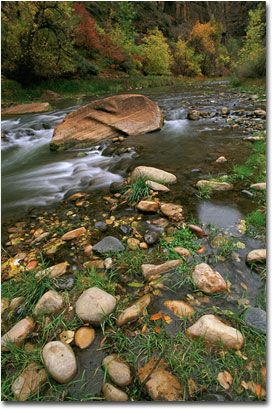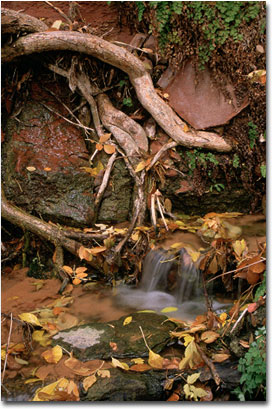|
|
 Workshop Impressions
Text and photography Copyright Jim Greenwood During sixteen years of practicing photography as a hobby, I have come to admire the work of numerous well-known professional photographers. Many of them make themselves available for instructional photographic workshops from time to time. However, I had never been inclined to participate in any such workshops of any kind. There were several reasons for this, not the least of which was the expense usually involved. But recently, following a significant milestone in my life, I decided to reward myself to a workshop led by renowned landscape photographer David Muench. The workshop was held in Zion National Park during the second week in November, at the peak of autumn color in Zion Canyon.
Somewhat ironically, I do feel that I actually benefited more from the workshop as an experienced amateur, than I would have as a novice. If I had participated in a workshop such as this when I was a beginner, I think I would have anticipated dramatic results. I would have expected to suddenly and magically enjoy considerable improvements in the quality of my photography. I most certainly would have been disappointed. There is a certain degree of talent which can only be achieved through years of experience behind the camera. Having had those years of experience under my belt, my expectations going in to the workshop were more modest. I knew that I already had the skills and experience to produce good photographs, so I could then focus my attention on more specific yet subtle ways in which I could produce better photographs. Throughout the workshop, both in the classroom and in the field, David frequently stressed the importance of two techniques related to basic image composition which when employed successfully can greatly improve the quality of an image. Although I had a prior awareness and understanding of both of these techniques, I consequently found myself thinking about them a lot more during the workshop. And even though I havenít done a great deal of photography since then, I have also found myself critiquing my own and other peopleís images with these aspects of composition in mind to a greater extent. I should point out that this workshop was of course intended primarily for landscape photographers, although these concepts can be easily applied to other types of photography as well. The first technique emphasized by David, that can lead to good image composition is to attain the best possible vantage point in order to achieve the most optimum arrangement of elements within an image. This method is one which most photographers usually consider to some extent, perhaps even subconsciously, although it can also be neglected at times or not given enough deliberate thought when composing an image. More specifically, he stressed separation of the key elements so that each could be easily identified within an image, as well as the arrangement or orientation of one or more key elements in such a manner as to lead the viewer into or through the image.
A second technique which can be utilized to achieve good composition is what David referred to as ďtensionĒ. Tension is usually something most people struggle to avoid or minimize in their lives. But when it comes to a good photograph, tension is often something to strive for, and is a positive quality. There are numerous ways in which tension can be achieved compositionally. Iíll briefly mention just a few. One way in which tension can be achieved is through the successful combination of dynamic and static elements within an image, such as flowing water or a moving subject within a tranquil scene. Tension can also be accomplished by capturing complementary colors, or warm and cool tones within a scene. A third way to achieve tension is to capture a variety of patterns or shapes within an image. The second image is an example of a photograph with a lot of tension. This image is, in fact, my interpretation of a composition suggested by David. It was raining fairly steadily at the time he made the suggestion, and I didnít spend the time setting up for any shots. I remained in Zion for a couple of days following the conclusion of the workshop, during which time I returned to the location and took the photograph. There is considerable tension within the upper portion of the image, which contains a multitude of strong shapes, angles and textures formed by the exposed rocks and tree roots embedded in the eroded soil. The flowing water and fallen leaves in the lower portion of the scene in fact add to the overall tension of the image as a whole due to the contrasting softer and more subdued shapes and textures of these elements compared to the elements in the upper portion. Thereís a lot going on in this image, but not so much that it seems chaotic. In conclusion, I thoroughly enjoyed my first workshop, and I am certain that Iím a better photographer as a result of the experience. I look forward to attending more workshops in the future. I would recommend workshop participation to any photographer who is currently uncertain about the benefits as I was. However, I will reiterate my earlier qualification that I think it would be advantageous to have at least a moderate level of skill and experience prior to attending your first workshop, especially one led by a distinguished master photographer like David Muench. Jim Greenwood - NPN 013 Comments on NPN nature photography article? Send them to the editor. |
|
|
 Over the years, I have been most strongly influenced and inspired by the images of a few select American southwestern landscape photographers, including David Muench. Yet, Iíve also always been very cautious against being overly influenced. Iíve always felt that itís very important to ďfollow my own pathĒ so to speak, to pursue and enjoy photography on my own terms, and to cultivate my own personal style as much as possible. This point of view had been a significant reason for my relatively low appreciation for the benefits of workshops during my pursuit of photography. Another reason that I had always shied away from workshops is that for me, as I would surmise that it is for many nature and wildlife photographers, the greatest rewards and learning experiences associated with this pastime are best achieved in solitude, engaging in the singular pursuit of the creative process, attempting to learn from and correct my own mistakes, and improving upon my own successes. However, while I still hold to both of these convictions for the most part, I will admit that, as a result of my experiences during this workshop, I now have a greater respect for the value of the workshop experience in general.
Over the years, I have been most strongly influenced and inspired by the images of a few select American southwestern landscape photographers, including David Muench. Yet, Iíve also always been very cautious against being overly influenced. Iíve always felt that itís very important to ďfollow my own pathĒ so to speak, to pursue and enjoy photography on my own terms, and to cultivate my own personal style as much as possible. This point of view had been a significant reason for my relatively low appreciation for the benefits of workshops during my pursuit of photography. Another reason that I had always shied away from workshops is that for me, as I would surmise that it is for many nature and wildlife photographers, the greatest rewards and learning experiences associated with this pastime are best achieved in solitude, engaging in the singular pursuit of the creative process, attempting to learn from and correct my own mistakes, and improving upon my own successes. However, while I still hold to both of these convictions for the most part, I will admit that, as a result of my experiences during this workshop, I now have a greater respect for the value of the workshop experience in general. The first image above, taken during the workshop, is an example of the successful use of this technique. The chosen vantage point for the shot was such that the arrangement of stones in the foreground directs the viewer upstream into the scene and towards the large boulder, which is separated nicely from the rest of the scene by the flowing water of the Virgin River. While at the boulder, the eye is led slightly downstream by the whitewater cascade, and also further upstream into the scene along the left bank of the river past the muted autumn foliage in the background.
The first image above, taken during the workshop, is an example of the successful use of this technique. The chosen vantage point for the shot was such that the arrangement of stones in the foreground directs the viewer upstream into the scene and towards the large boulder, which is separated nicely from the rest of the scene by the flowing water of the Virgin River. While at the boulder, the eye is led slightly downstream by the whitewater cascade, and also further upstream into the scene along the left bank of the river past the muted autumn foliage in the background.